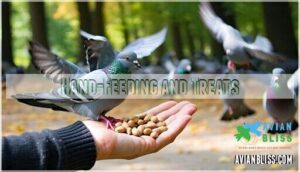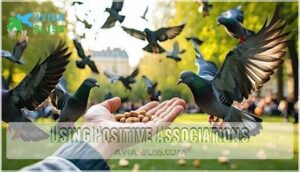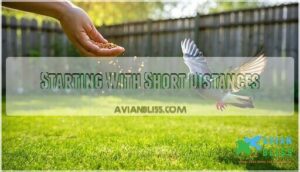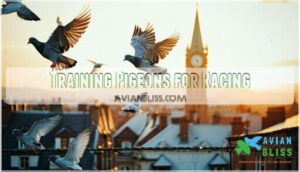This site is supported by our readers. We may earn a commission, at no cost to you, if you purchase through links.
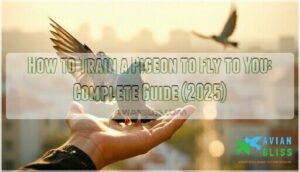 Training a pigeon to fly to you starts with building trust through consistent hand-feeding and daily interaction.
Training a pigeon to fly to you starts with building trust through consistent hand-feeding and daily interaction.
You’ll need to establish yourself as their primary food source, creating a strong bond that makes them want to return. Begin with short flights in a secure area, gradually increasing distance as your pigeon’s confidence grows.
Use verbal cues and hand signals consistently—pigeons are surprisingly smart and learn patterns quickly. The secret lies in their natural homing instincts combined with positive reinforcement.
Think of it as creating an invisible thread that pulls them back to you. The real magic happens when you understand their unique behavioral triggers.
Table Of Contents
- Key Takeaways
- Getting Started With Pigeon Training
- Building Trust and Bonding With Your Pigeons
- Establishing a Training Routine
- Ensuring Safety and Security
- Training Pigeons for Racing
- General Tips for Pigeon Care and Training
- Frequently Asked Questions (FAQs)
- How to train a pigeon to come to you?
- How do I teach my pigeon to fly?
- How to get a pigeon to come up to you?
- How long does it take for pigeons to learn to fly?
- How long does pigeon training typically take?
- What age is too old to start training?
- Can pigeons be trained in winter months?
- How do pigeons navigate back home naturally?
- What happens if my pigeon gets lost?
- Conclusion
Key Takeaways
- You’ll build trust through daily hand-feeding with treats like unsalted peanuts, establishing yourself as their primary food source and creating a strong bond that makes them want to return to you.
- Start with short flights of just 3 feet and gradually increase distance by following the 5-mile weekly rule, using consistent hand signals and verbal cues like "come" to create clear communication.
- You’ll need proper housing with at least 10 cubic feet per pigeon pair, quality nutrition, and a secure loft with both indoor and outdoor spaces to create a safe home base they’re motivated to return to.
- Focus on positive reinforcement and patience rather than forcing interactions—reward correct responses within three seconds and let pigeons approach naturally to build confidence and strengthen their homing instincts.
Getting Started With Pigeon Training
Before you can teach a pigeon to fly back to you, you’ll need to select healthy birds from reputable breeders.
You’ll also need to create proper housing with at least 8-10 cubic feet per pair, and provide quality nutrition.
Your success depends on establishing a secure loft with indoor and outdoor spaces, and budgeting for ongoing training costs that’ll turn your feathered friends into reliable fliers.
Choosing The Right Pigeon
Success starts with selecting quality pigeons from reputable breeders who prioritize lineage importance and breed characteristics.
Quality breeding stock is the foundation of every successful pigeon training program.
Focus on homing pigeons between 4-6 months old, as they’re most trainable. During health evaluation, look for bright eyes, smooth feathers, and strong wing muscles.
Temperament assessment matters too—choose calm, curious birds that respond well to human presence. Consider acquisition options carefully, avoiding stressed or unhealthy specimens from questionable pigeon breeding operations.
Top graders often select birds based on proven champion breeders, prioritizing quality pigeons with a strong breed characteristics and from reputable breeders who understand the importance of selecting quality.
Creating Suitable Housing
Your pigeon loft needs careful planning to create the perfect home base. Space requirements demand at least 10 cubic feet per pigeon pair – cramped quarters lead to stressed birds.
Design your shelter with both indoor and outdoor sections, using wire mesh walls for proper loft ventilation while maintaining predator protection. A vital aspect involves ensuring optimal height placement to promote safety and accessibility.
Here’s your housing checklist:
- Install roosting perches at varying heights for comfort
- Add dedicated nest boxes with quality nesting materials
- Choose location considerations that avoid overhead wires and trees
Smart pigeon lofts combine safety with comfort, setting the foundation for successful training.
Providing Proper Nutrition and Care
After setting up your loft, proper nutrition becomes your foundation for successful pigeon training.
A balanced pigeon diet directly impacts flight performance and homing ability.
Quality pigeon feed contains essential grains, proteins, and minerals that fuel strong wings and sharp navigation instincts.
| Feed Component | Daily Amount | Purpose | Notes |
|---|---|---|---|
| High-quality pigeon feed | 1-1.5 oz per bird | Primary nutrition source | Adjust for racing/breeding seasons |
| Fresh water | Unlimited access | Hydration and digestion | Change daily for water quality |
| Grit supplement | Small pinch weekly | Aids digestion | Helps break down seeds |
| Calcium source | As needed | Bone/eggshell strength | Especially important for breeding pairs |
Monitor your birds daily for health signs.
Clean feeders prevent disease spread, supporting loft hygiene.
Remove uneaten food after twenty minutes to maintain freshness.
Schedule regular vet checkups for preventative care, ensuring your pigeons stay flight-ready and responsive to pigeon care routines.
Building Trust and Bonding With Your Pigeons
You’ll need to establish a solid foundation of trust before your pigeons will reliably fly to you, and this process requires patience, consistency, and positive reinforcement techniques.
Building this bond isn’t just about training commands—it’s about creating a relationship where your pigeons associate you with safety, food rewards, and comfortable interactions that make them want to return to you time after time.
Hand-Feeding and Treats
Hand-feeding creates the foundation for successful pigeon training through positive reinforcement and food rewards.
Building trust through treats transforms ordinary birds into loyal companions who eagerly return to your call.
Start with unsalted peanuts, sunflower seeds, or quality pigeon pellets in your palm. Young birds adapt quickly to handfeeding, while adult rescues need patience.
Establish a consistent feeding schedule to build trust and meet their dietary needs. Never force interaction—let them approach naturally.
This gentle method strengthens your bond and makes future bird training sessions more effective through food rewards.
Spending Quality Time Together
When you invest daily time in gentle handling and interactive play, you’re building the foundation for successful pigeon recall.
These intelligent birds crave companionship and respond beautifully to consistent, positive interactions. Sit quietly near their space, allowing them to approach on their terms.
This patient approach creates building familiarity that strengthens your bond naturally.
Quality time activities that enhance pigeon training include:
- Reading aloud while they perch nearby, creating a safe environment
- Offering treats during calm moments for positive reinforcement
- Playing soft music to enrich their surroundings
- Speaking their names gently to build recognition and trust
Using Positive Associations
Creating strong positive associations forms the backbone of successful pigeon training.
Use consistent reinforcement by pairing your voice with treats—say their name while offering peanuts. This reward system builds confidence and strengthens pigeon recall.
Avoid punishment entirely, as it breaks trust.
Association cues like specific sounds or gestures help pigeons connect actions with rewards, making training techniques more effective.
Establishing a Training Routine
Creating a consistent training routine is essential for teaching your pigeon to fly back to you reliably.
You’ll start with very short distances of just a few feet and gradually increase the flight distance each week, using positive reinforcement and clear hand signals to guide your pigeon’s learning process, with a focus on reliable flight back to you.
Starting With Short Distances
Your pigeon’s journey begins with baby steps—literally just a few feet away from your outstretched hand. These Initial Releases should feel like a gentle conversation between you and your bird.
Place your pigeon three feet away, then call softly while offering their favorite treat. When they hop or flutter to you, immediately activate your Reward System with praise and food.
You can find a variety of pigeon training treats online. This Confidence Building approach helps establish a clear Flight Path without overwhelming your feathered friend.
Early Challenges like hesitation are normal during pigeon training. Patience and positive reinforcement make training pigeons successful through consistent bird recall practice.
Gradually Increasing Distance and Difficulty
Once your pigeons master short flights, it’s time to challenge them further.
Distance Progression should follow the 5-mile weekly rule, while Route Variation keeps their navigation sharp. Weather Adaptation builds resilience, and Endurance Training strengthens flight muscles.
Your training schedule should include:
- Weekly distance increases that build confidence gradually
- Multiple flight paths that prevent predictable routes
- Weather condition variety that creates real-world readiness
Using Hand Signals and Verbal Cues
Once your pigeons master basic distances, clear communication becomes your secret weapon. Hand signals and verbal cues create a reliable language between you and your feathered friends.
Signal Consistency matters most—use identical gestures every time. Raised arms at 45-degree angles work perfectly for "come here" commands, while open palms invite landing.
To better understand your pigeon’s emotional state, pay attention to their flashing or dilating pupils.
| Signal Type | Technique | Purpose |
|---|---|---|
| Approach Signal | Raised arm at 45° | Calls pigeon to you |
| Landing Cue | Open upward palm | Invites perching |
| Direction Guide | Pointing gesture | Shows flight path |
| Reward Signal | Treat in hand | Motivates return |
| Release Command | Gentle push motion | Signals departure |
Cue Clarity prevents confusion—choose short, distinct words like "come" or "here." Practice Command Variety to expand your pigeon’s vocabulary.
Remember, Reinforcement Timing is everything—reward within three seconds of correct responses. These Visual Aids combined with consistent verbal cues transform ordinary pigeons into responsive partners who enthusiastically fly to your call.
Ensuring Safety and Security
You’ll need to protect your feathered athletes from hawks, cats, and other threats that can turn training flights into dangerous adventures.
Weather monitoring and escape prevention strategies become your best tools for keeping pigeons safe while they learn to navigate back to you reliably.
Protecting Pigeons From Predators
Once your training routine’s established, safeguarding your feathered friends becomes paramount.
Urban hawks, cats, and raccoons pose serious threats to pigeons. Install sturdy loft security with wire mesh and overhead netting.
Use predator deterrents like reflective surfaces and motion sensors around housing. During supervised free-flight sessions, maintain vigilant flock protection.
These safety precautions prevent injuries and guarantee your pigeon training investment stays protected from harm. Prioritize complete pigeon protection to guarantee their well-being and ensure complete protection.
Monitoring Weather Conditions
Weather monitoring becomes your pigeon’s lifeline during training.
Check wind direction before each session—crosswinds exceeding 15 mph can disorient birds. Monitor temperature effects, as extreme heat or cold impacts flight performance.
High humidity reduces visibility concerns, while dropping barometric pressure signals incoming storms. Adjust your training schedule accordingly.
Smart weather awareness keeps your feathered friend safe aloft. For ideal conditions, consider the impact of light winds on activity, which is crucial for safe and successful training sessions.
Preventing Loss or Escape
Smart escape prevention starts with secure loft design featuring proper latches and predator-proof mesh.
The wing clipping debate remains controversial, but training recall reliability through consistent practice works better.
Identify hazards like open windows or gaps before sessions.
Establish emergency procedures for lost birds, including contact networks with local pigeon clubs, and these training techniques and loss prevention strategies keep your feathered friends safe while building trust.
These measures are crucial for maintaining a safe environment.
Training Pigeons for Racing
Racing pigeons are the athletes of the bird world, and training them requires a systematic approach that builds their speed, endurance, and navigation skills over months of careful conditioning.
You’ll need to select birds with strong genetic backgrounds for racing, gradually increase their flight distances from one mile to hundreds of miles.
And connect with local racing clubs to learn competition strategies and gain access to organized events.
Choosing Suitable Racing Pigeons
Racing champions aren’t born overnight—they’re carefully selected based on proven lineage importance and breed characteristics.
You’ll want homing pigeons from reputable breeders who can show you their birds’ racing records. Look for strong wing structure and good muscle mass, plus clear health indicators like bright eyes and smooth feathers.
These genetic traits directly impact homing ability. Top pigeon racing organizations keep detailed records, so don’t settle for mystery bloodlines when champions are available, ensuring you get the best based on their racing records.
Joining Racing Clubs and Seeking Advice
Connecting with local pigeon racing clubs opens doors you didn’t know existed.
The American Racing Pigeon Union helps you find nearby groups where expert mentorship flows freely.
These networking opportunities provide invaluable pigeon racing tips from veterans who’ve mastered homing pigeons through decades of experience.
Club benefits include access to training resources, understanding racing rules, and learning proven techniques.
Experienced members enthusiastically share their knowledge about pigeon training methods that actually work.
You’ll discover strategies that transform amateur efforts into competitive success stories.
Monitoring Races and Strategies
After connecting with racing clubs and getting advice from experienced trainers, you’ll need to monitor your bird’s performance like a hawk. Successful pigeon racing strategies depend on careful observation and smart adjustments.
Here’s how to track your homing pigeons effectively:
- Race Analysis – Record flight times, weather conditions, and performance patterns for each training session
- Weather Impact – Monitor wind speeds, temperature, and visibility that affect your pigeon’s navigation abilities
- Pigeon Health – Check for injuries, exhaustion, or stress after each flight to prevent long-term issues
- Training Adjustments – Modify pigeon training distance and frequency based on your bird’s progress and stamina
- Competitor Analysis – Study other racers’ techniques and adapt successful pigeon racing training methods
Smart pigeon racing requires patience and attention to detail. Understanding how pigeons use geomagnetic cues can further refine your approach. Track your bird’s improvement over time, and don’t rush the process. Your feathered athlete needs consistent monitoring to reach peak performance.
General Tips for Pigeon Care and Training
Successful pigeon training depends on three essential care practices that’ll keep your birds healthy and keen to return home.
You’ll need to maintain a spotless loft environment, establish regular veterinary checkups with an avian specialist, and create a secondary training location that encourages your pigeons’ natural homing instincts.
Maintaining Cleanliness and Hygiene
Keep your pigeon loft spotless – it’s like maintaining your own home.
Clean droppings daily and replace bedding weekly for proper waste management.
Fresh water prevents disease prevention issues, while regular loft sanitation stops parasites dead in their tracks.
Bathing frequency should be twice weekly, and good cleanliness and hygiene practices keep your feathered friends healthy and happy.
Consulting a Bird-Specific Vet
Beyond maintaining a spotless loft, your pigeons deserve specialized healthcare from an avian veterinarian who understands their unique needs.
Regular checkups help catch pigeon diseases early, preventing costly emergency bird care situations down the road. A key aspect involves recognizing signs of illness in your birds.
Think of preventative pigeon care as an investment in your flock’s future success.
Here’s what to discuss with your vet:
- Pigeon health screenings and disease diagnosis protocols
- Recommended pigeon vaccines and supplement schedules
- Medication side effects to watch for during treatment
- Avian veterinarian costs and budgeting for routine care
By following these steps, you can ensure your pigeons receive the best possible care, and you can avoid costly emergencies by catching any potential issues early.
Creating a Second Home for Pigeons
Establishing a second home strengthens homing instincts through two-way training between pigeon lofts.
Strategic loft placement creates new flight paths, encouraging mobility while building shelter association.
Alternate feeding at both locations motivates your homing pigeons to navigate confidently between sites.
This dual-home setup challenges birds with varied routes and distances, deepening their natural navigation abilities.
You’ll notice improved flight performance as they master multiple departure points during pigeon training sessions.
Frequently Asked Questions (FAQs)
How to train a pigeon to come to you?
Start by hand-feeding your pigeon daily treats like unsalted peanuts.
Use gentle movements and calm voice tones.
Gradually increase distance while calling consistently.
Practice patience—trust builds slowly through positive reinforcement and regular interaction sessions.
How do I teach my pigeon to fly?
Unlike teaching tricks, flight training focuses on building your pigeon’s natural abilities.
Begin with short indoor flights, then gradually move outdoors.
Use treats and patience—your bird’s confidence grows with consistent practice and positive reinforcement.
How to get a pigeon to come up to you?
Hand-feed your pigeon daily treats like unsalted peanuts while speaking softly.
Sit quietly nearby without forcing interaction. Move slowly and let the bird approach you naturally.
Patience and consistent positive reinforcement build trust over time.
How long does it take for pigeons to learn to fly?
Baby pigeons typically fledge at 25-28 days old, but they won’t master flight for another week.
You’ll see them take their first wobbly flights around day 35, gaining confidence and coordination through practice.
How long does pigeon training typically take?
Pigeon training typically takes 8 weeks on average, though it varies by individual bird and training goals. You’ll start seeing progress within days, but consistent daily sessions are key to success.
What age is too old to start training?
Training success drops substantially after six months of age.
You’ll find best results starting between 6-8 weeks old.
Adult pigeons can still learn, but they’re more stubborn and take longer to develop strong homing instincts.
Can pigeons be trained in winter months?
Winter training isn’t impossible, but it’s brutally challenging.
Cold weather reduces your pigeon’s flight endurance and motivation.
You’ll need to adjust expectations, provide extra nutrition, and choose milder days for shorter training sessions.
How do pigeons navigate back home naturally?
Your feathered friends use an incredible combination of magnetic fields, sun positioning, and landmark recognition to find their way home.
They’ve got built-in compasses that detect Earth’s magnetic pull, making them nature’s GPS masters.
What happens if my pigeon gets lost?
Lost birds often return within days using their natural homing instincts.
You’ll need patience while they navigate back.
Reduce training distances temporarily, check local reports, and make certain your loft remains welcoming with food and water available, utilizing their natural ability to find their way back through complete concepts.
Conclusion
Surprisingly, many successful pigeon trainers started with accidental discoveries—a bird that wouldn’t leave their windowsill or kept returning to their yard.
Learning how to train a pigeon to fly to you transforms this coincidence into a reliable skill.
Remember, patience beats speed every time.
Start with trust-building, establish consistent routines, and respect your pigeon’s natural instincts.
With proper technique and dedication, you’ll develop an unbreakable bond that brings your feathered friend home reliably, creating a partnership built on mutual respect and understanding.
- https://elearningnew.ul.edu.lr/fetch.php/scholarship/404079/ManagementOfRacingPigeonsAvianMedicine.pdf
- https://www.quora.com/Im-thinking-about-getting-a-bird-as-a-pet-What-kind-of-care-do-they-require
- https://www.facebook.com/groups/1734947773458173/posts/4106714602948133/
- https://www.ncbi.nlm.nih.gov/books/NBK500439/
- https://www.acs.edu.au/courses/bird-keeping-aviculture-707.aspx

